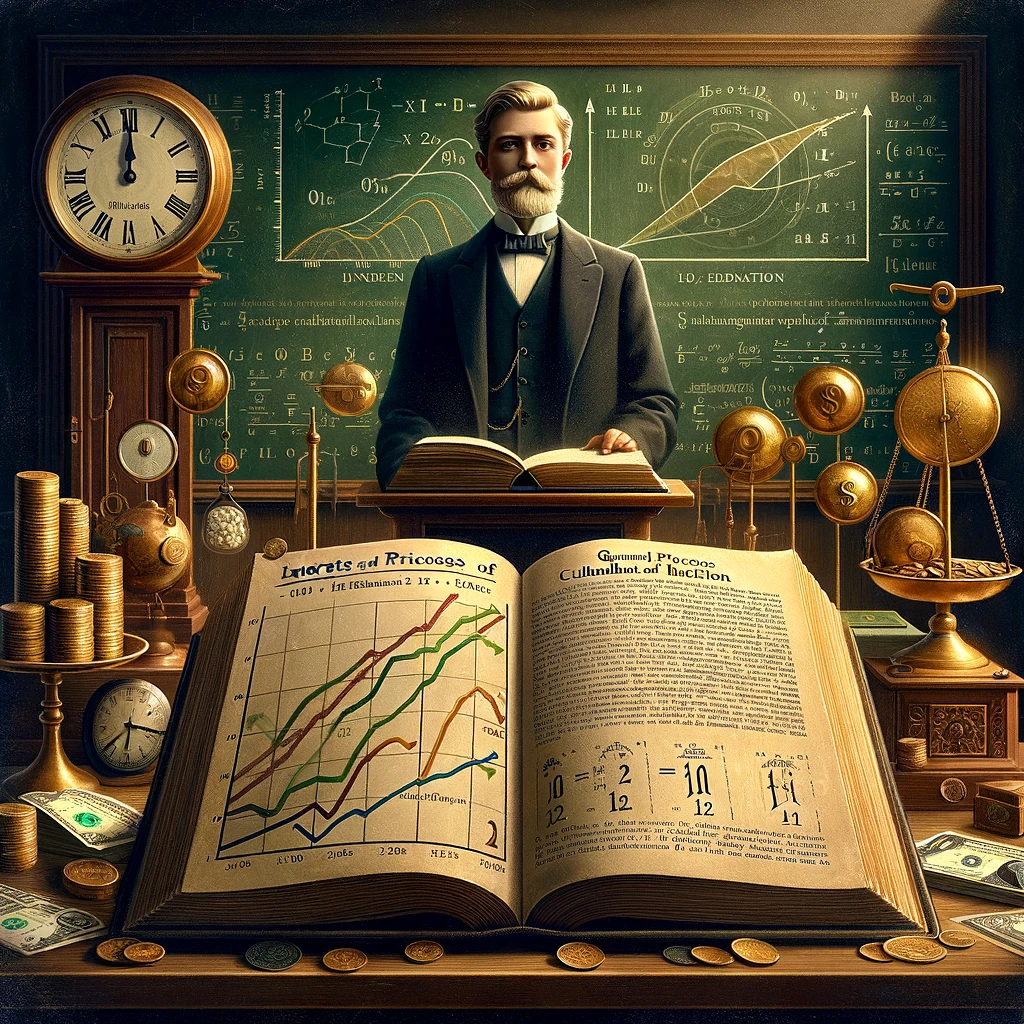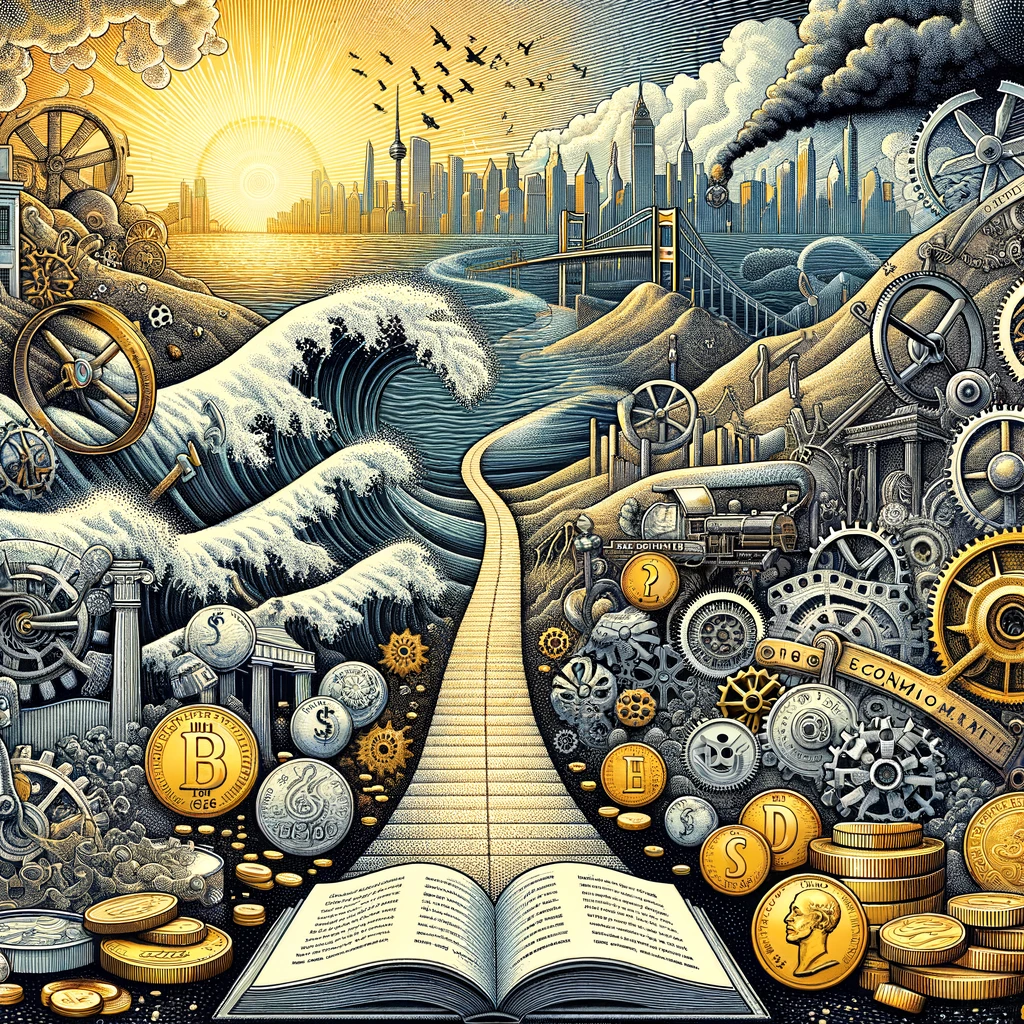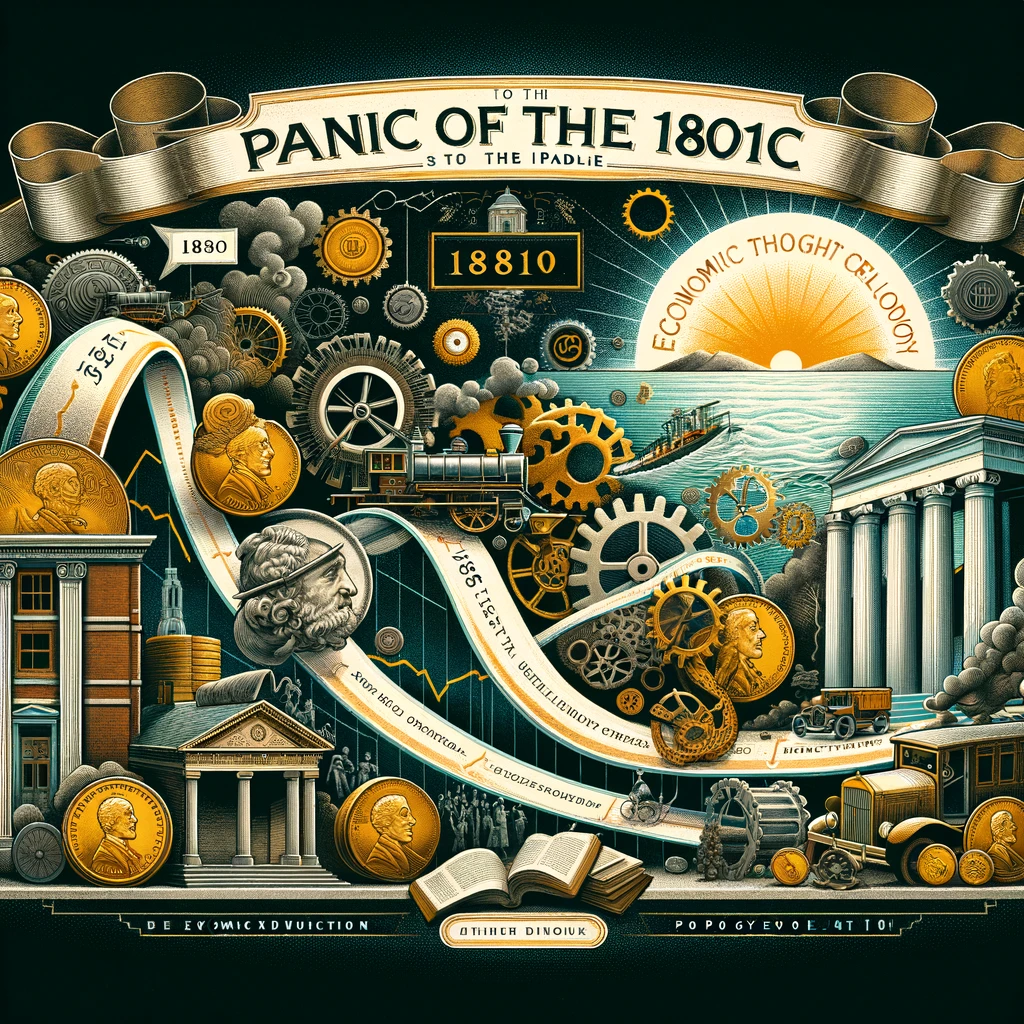Chapter 12.7: Bridging Eras: Economic Thought from Mises to Keynes
Opening Statement

The image was created to visually represent the transition from economic turmoil to intellectual transformation during the period from 1881 to 1936. If there is anything more you would like to add or adjust, just let me know!
From Turmoil to Transformation: The Role of Historical Insights in Shaping Modern Economic Thought.
The profound contributions of Ludwig von Mises with the broader narrative of economic evolution from 1881 to 1936 illuminate a period of intellectual ferment and foundational change. The exploration, as presented in previous chapters, sketches a vibrant mosaic of economic theory in motion, challenging and redefining the contours of classical liberalism and beyond. Notably, Chapter 12.6, "The Enduring Wisdom of Ludwig von Mises: A Prelude to Modern Economic Thought," serves not only as a testament to von Mises' indelible mark on economic philosophy but also as a crucial pivot towards the expansive dialogues that ensue.
As we advance into Chapter 13, our narrative widens to encompass the tumult and triumphs of an era beset by significant upheavals. These times of trial, marked by events such as the Panic of 1819, underscore the devastating repercussions of unbridled financial systems and the nascent understanding of economic cycles. Such crises, with their extensive bank failures and economic contractions, become a canvas upon which the dire need for regulatory insight and policy innovation is starkly painted.
Nevertheless, it is within this tapestry of challenge and change that the insights of Ludwig von Mises resonate with renewed significance. His acute analyses, grounded in a keen awareness of historical economic events like hyperinflation in France and the financial panics in America, provide a framework for interpreting the economic tumult of the 19th and early 20th centuries. Mises's emphasis on the perils of government intervention and the virtues of market dynamics and individual choice becomes a precursor to understanding the complexities of the period covered in Chapter 13.
This fusion of historical insight and theoretical breakthroughs, spanning from Mises' timeless wisdom to the groundbreaking economic policies and theories that followed, offers a holistic perspective on the development of economic thought. Guided by historical examples, the narrative navigates the complexities of a time that faced significant challenges yet laid the foundations for today's economic framework.
Through the lens of historical events and the analytical prowess of figures like Mises, we are invited to witness the gestation of modern economic theories—a journey from the turmoil of financial crises to the transformative power of intellectual evolution. This unfolding story, emblematic of resilience and ingenuity, forms the bedrock of our understanding of economics as a discipline perpetually in dialogue with its past yet firmly oriented towards the future.
The Genesis of the Austrian School

The story begins with Carl Menger's "Principles of Economics" in 1871, introducing the concept of marginal utility and setting the stage for the Austrian School of Economics. Menger's work challenged the classical theories of value, emphasising individual choice and subjective value in determining prices. This foundational work provided the bedrock for Ludwig von Mises and his contributions to economic thought.
Here is the artistic representation centred around the "Principles of Economics" by Carl Menger, reflecting the early days of the Austrian School of Economics.
Mises and the Theory of Money and Credit

In 1912, Ludwig von Mises published "The Theory of Money and Credit," integrating monetary theory with the broader economic analysis. Mises's work extended Menger's ideas, introducing the notion of the business cycle driven by credit expansion and its impact on the economy. This groundbreaking theory not only highlighted the role of monetary policy in economic fluctuations but also preempted the discussions on inflation and economic stability that would dominate the 20th century.
Here is the illustration that reflects the themes of Ludwig von Mises's 'The Theory of Money and Credit'.
The Expansion of Microeconomic Analysis

Parallel to the developments in the Austrian School, Alfred Marshall's "Principles of Economics" in 1890 expanded the scope of economic analysis by introducing the concept of price elasticity of demand. Marshall's work laid the foundations for microeconomics, focusing on individual markets and the behaviour of consumers and firms. His analysis of supply and demand, costs of production, and market structures enriched the economic discourse, providing tools that are still central to economic analysis today.
Wicksell and the Cumulative Process of Inflation

Knut Wicksell's contribution in 1900 with "Interest and Prices" introduced the theory of the cumulative process, a pivotal concept in understanding inflation. Wicksell's insights into the relationship between the money supply, interest rates, and price levels illuminated the dynamics of inflationary processes, influencing subsequent economic policies aimed at stabilising economies.
Here is the visualisation centred around Knut Wicksell's theory of the cumulative process of inflation, capturing both the essence of his insights and the historical context of his work.
The Keynesian Revolution

Here is the image capturing the revolutionary shift to Keynesian economics, marked by John Maynard Keynes's pivotal work.
The narrative reaches a critical juncture with the publication of John Maynard Keynes's "The General Theory of Employment, Interest and Money" in 1936. Keynes's work challenged the prevailing notions of classical economics, arguing that economies could sustain high levels of unemployment. His advocacy for government intervention to regulate economic cycles heralded a new era of economic thought, giving rise to Keynesian economics. Keynes's theories on fiscal and monetary policies, consumption, and investment became the cornerstone of macroeconomic policy in the post-World War II era.
A Continuum of Thought

Chapter 12.7 encapsulates an era that bridges pivotal moments in the history of economic thought, from the foundational insights of Menger and the Austrian School to the transformative concepts introduced by Keynes. This period stands out for its deep examination and challenge of established economic theories, paving the way for new paradigms that still underpin monetary policy and theory today. As we navigate this continuum of thought, we uncover the evolving landscape of ideas that have profoundly influenced the modern economic world.
Here is the image capturing the conceptual transition from the academic discussion of the Panic of 1819 to the exploration of economic milestones leading to the Great Depression, symbolising a journey through economic evolution and critical concepts over time.
Transitioning to Chapter 12.8: "Foundations and Turmoil: Tracing Economic Milestones from Bimetallism to The Great Depression," we broaden our exploration beyond the intellectual exchanges between critical economic theorists to examine the pivotal events and developments that defined the late 19th and early 20th centuries. This shift underscores our narrative's progression, from dissecting theories to contextualising them within significant economic milestones that have shaped contemporary economic thought and policy.

Here is the image capturing the transition from discussions of economic theories to the examination of pivotal events and developments from the late 19th to the early 20th century, symbolising the narrative progression from theory to significant historical economic events.
Integrating the Panic of 1819: A Reflective Examination
As we delve into the evolution of economic thought and policy from 1881 to 1936, our narrative momentarily steps back to a seminal event that predates our primary timeline: the Panic of 1819. Though this critical juncture falls outside our central period, its impact looms large over the subsequent developments. It acts as a crucial prelude, enriching our understanding of economic crises' cyclical nature and the adaptive responses they necessitate.

The Panic of 1819, the United States' first significant peacetime financial crisis, was marked by extensive bank failures and economic downturns. The repercussions of this event reverberated through society, moulding public and governmental perceptions of banking, credit, and regulatory frameworks. It thus established a foundation for the intellectual and policy shifts witnessed in the ensuing decades, providing a backdrop for the deeper exploration of economic dynamics in Chapter 12.8.
Here is the image that visually encapsulates the integration of the Panic of 1819 into the broader narrative of economic thought and policy evolution.
By situating the Panic of 1819 within our discussion, we not only gain a more nuanced understanding of economic thought's continuity and transformation but also underscore the importance of historical context in grasping the complexities of economic evolution. Although the Panic might seem a distant chapter in the annals of economic history, its lessons remain indispensable, echoing through the debates and decisions that have sculpted the economic landscapes of the late 19th and early 20th centuries. Thus, while it may seem we are detouring into the past, this reflective journey is purposeful and enlightening, emphasising the pivotal role of historical events in shaping our understanding of economic theory and policy.
Leave a Reply